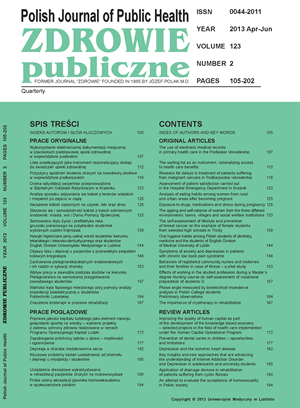Application of drainage devices in rehabilitation of patients suffering from cystic fibrosis
DOI:
https://doi.org/10.12923/j.0044-2011/123-2/a.19Keywords:
cystic fibrosis, mucociliary transport, chest wall oscillationAbstract
Cystic fibrosis is a chronic and incurable disease, caused by a mutation of a gene, which codes the ionic canal CFTR, which ensures correct hydration of the mucus of the epithelial glands (95% of water in healthy people). In the case a mutation is detected, a considerable concentration of mu-cus occurs in numerous organs of the organism, in particular the respiratory and digestive systems. Applying active techniques of bronchi cleaning with the use of drainage devices constitutes one of the most important elements of comprehensive physiotherapeutic procedure. Nowadays, it is recommended to teach, as early as possible, to practically use drainage devices increasing the expiratory pressure or changing the pressure in the lumen of the bronchial tree, i.e.: PEP mask, Flutter or Acapella. Apart from the high efficiency of the therapy, they provide independent functioning of the patient in social life, without the dependence on people from the outside.
References
1. Zielonka TM. Rola lekarzy rodzinnych w wykrywaniu chorób układu oddechowego – część II. Forum Med Rodz. 2011;5(6):468-74.
2. Daniels T. Physiotherapeutic managment strategies for the treatment of cystic fibrosis in adults. J Multidiscip Healthc. 2010;3:201-12.
3. Sawicki SG, Tiddens H. Managing treatment complexity in Cystic Fi¬brosis: Challenges and opportunities. Pediatr Pulmonol. 2012;47:523- 33.
4. Hristara-Papadopoulou A, Tsanakas J, Diomou G, Papadopoulou O. Cur¬rent devices of respiratory physiotherapy. Hippokratia. 2008;12(4):211- 20.
5. Mazurek H. Mukowiscydoza. Warszawa: Medical Tribune Polska; 2012. p.141.
6. Paprocka-Borowicz M, Demczyszak I, Kuciel-Lewandowska J. Fiz¬joterapia w chorobach układu oddechowego. Wrocław; 2009.
7. Homnick DN. Making airway clearance successful. Paediatr Respir Rev. 2007;8:40-5.
8. Elkins MR, Jones A, van der Schans C. Positive expiratory pressure physiotherapy for airway clearance in people with cystic fibrosis. Cochrane Database Syst Rev. 2006;2:CD003147.
9. Pisi G, Chetta A. Airway clearance therapy in cystic fibrosis patients. Acta Biomed. 2009;80:102-6.
10. Myers TR. Positive expiratory pressure and oscillatory positive expira¬tory pressure therapies. Respir Care. 2007;52(10):1308-26.
11. Darbee JC, Kanga JF, Ohtake PJ. Physiologic evidence for high-frequency chest wall oscillation and positive expiratory pressure breathing in hospitalized subjects with cystic fibrosis. Phys Ther. 2005;85(12):1278-89.
12. Airway Clearance Devices for Cystic Fibrosis. Ontario Health Technol¬ogy Assessment Series. 2009;9(26):13-4.
13. Santos AP, Guimaraes RC, Carvalho EM. Mechanical Behaviors of Flut¬ter VRP1, Shaker and Acapella Devices. Respir Care. 2013;58(2):298- 304.
14. Schechter M. Airway clearance in Cystic Fibrosis: Is there a better way? Respir Care. 2010;55(6):782-3.
15. Bradley JM. High frequency chest wall oscillation in cystic fibrosis. Thorax. 2010;65:189-90.
16. Dobosz K. Zastosowanie systemu oczyszczania dróg oddecho-wych The Vest u osób chorych na mukowiscydozę. Mukowiscydoza. 2009;23(5):5-8.
17. Oermann CM, Socksrider MM, Giles D. Comparision of high – frequen¬cy chest compression therapy on pulmonary complications of cystic fibrosis. Pediatr Pulmonol. 2001;32:372-7.
18. Alkiewicz J. Leczenie inhalacyjne i rehabilitacja układu oddechowego dzieci i dorosłych. Wrocław:Volumed;1995.
19. Kempainen RR, Milla C, Dunitz J. Comparison of settings used for High-Frequency. Chest-Wall Compression in Cystic Fibrosis. Respir Care. 2010;55(6):695-9.
20. Phillips GE, Pike SE, Jaffe A. Comparision of active cycle of breathing and high – frequency oscillation jacket in children with cystic fibrosis. Pediatr Pulmonol. 2004;37:71-5.
21. Pryor JA, Tannenbaum E, Scott SF, et al. Beyond postural drainage and percussion: Airway clearance in people with cystic fibrosis. J Cyst Fibros. 2010;9:187-92.


